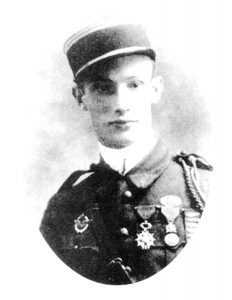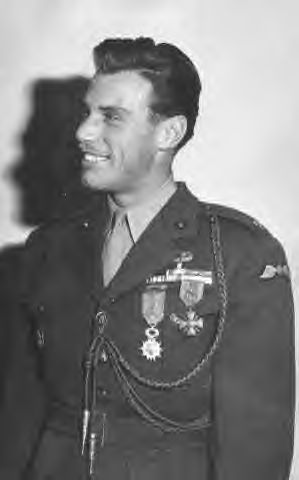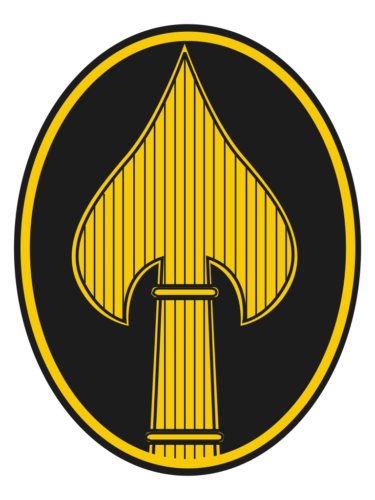Peter J. Ortiz.
Peter Julien Ortiz, born on July 5, 1913, in New York City, was the son of a French-Spanish father and an American mother of Swiss descent. He spent his childhood in Soutern California before moving to France for his education at the University of Grenoble. Ortiz was a polyglot, fluent in ten languages, including English, Spanish, French, Italian, Portuguese, German, and Arabic.
At the age of 19, Ortiz joined the French Foreign Legion in 1932, serving in North Africa¹. He was promoted to corporal in 1933 and sergeant in 1935 while serving in Morocco. During a campaign against the Riffian people, he was awarded the Croix de Guerre twice and also received the Médaille militaire. After his contract expired in 1937, he returned to the U.S. and served as a technical adviser for war films in Hollywood.

World War II
With the outbreak of World War II, Ortiz re-enlisted in the French Foreign Legion in October 1939. He was wounded and captured by the Germans during the 1940 Battle of France. After escaping in 1941, he made his way to the U.S. Ortiz enlisted in the U.S. Marine Corps on June 22, 1942. Due to his training and experience, he was commissioned as a second lieutenant after only 40 days in service.
Ortiz was assigned to the Office of Strategic Services (OSS) Naval Command in 1943. He served in North Africa and Europe during the war, operating behind enemy lines several times. Ortiz was one of only 80 Marine Corps officers to serve in the OSS during World War II. He was wounded during an encounter with a German patrol in March 1943 and was sent back to the U.S. to recover. After his recovery, he continued to serve in the OSS.
In July, Ortiz was stationed in London, awaiting his assignment to France. His task was to assess the capabilities of the local resistance movement in the Vercors region of the Haute Savoie, a southeastern area of France, and subsequently organize and equip the Maquis in anticipation of the much-awaited D-Day assault.
To accomplish this, an inter-allied team known as UNION was formed, consisting of British, French, and American agents. Colonel Pierre Fourcaud represented the Free French forces, Col. H.H.A.Thackwaite, a former schoolmaster, represented the British Special Operations Executive (SOE), and Ortiz was the representative for the OSS/Special Operations (SO) from the U.S.
The team members, adhering to SOE’s standard practice, parachuted into France in civilian attire and later changed into their uniforms, marking the first appearance of Allied officers in uniform in France since 1940.Upon arrival, Ortiz and his team encountered numerous challenges—a lack of funds and transportation, inadequate security, scarce military supplies, and a general reluctance among the politically-divided resistance groups to cooperate. In May, the team was recalled to England for reassignment.

Ortiz, who had been promoted to Major and awarded the first of his two Navy Crosses, returned to France on August 1, 1944, leading a mission known as Union II, an OSS Operational Group (OG). Instead of engaging in espionage and intelligence gathering, the heavily armed OGs were tasked with “direct action”, which involved sabotage and preventing German units from destroying key installations as they retreated. Ortiz, under the codename “Chambellan,” was accompanied by five Marines, a Free French officer with falsified papers identifying him as a Marine, and an Army Air Forces captain.
During an unexpected encounter in Albertville with several hundred troops from the German 157th Alpine Reserve Division, Peter and his small team were quickly outnumbered. In light of recent German massacres of French civilians and the threat of German reprisals, Peter decided that surrender was the only option to protect the local population.
After his surrender on August 16, Peter was sent to the naval POW camp Marlag/Milag Nord, situated in the small German village of Westertimke, near Bremen, in northern Germany. He made several escape attempts until April 10, 1945, when the camp was hastily evacuated, and he managed to escape as a column of Spitfires attacked the retreating Germans.
After hiding for 10 days, Peter and two fellow POWs decided to return to their POW barracks on April 27—two days before the camp was liberated by the British 7th Guards Armored Division. Peter was then transported to Brussels and back to London, where he was awarded his second Navy Cross. According to OSS records, Peter was actually nominated for the Medal of Honor instead of a second Navy Cross, making him one of the few to ever receive such an honor. However, no OSS member has ever been awarded the Medal of Honor.

The OSS
The OSS was established during World War II as the intelligence agency of the United States. The formation of the OSS was prompted by President Franklin D. Roosevelt’s concern about American intelligence deficiencies. Before the formation of the OSS, various departments of the executive branch, including the State, Treasury, Navy, and War Departments, conducted American intelligence activities on an ad hoc basis, with no overall direction, coordination, or control. The U.S. Army and U.S. Navy had separate code-breaking departments: Signal Intelligence Service and OP-20-G.
On the suggestion of William Stephenson, the senior British intelligence officer in the western hemisphere, Roosevelt requested that William J. Donovan draft a plan for an intelligence service based on the British Secret Intelligence Service (SIS/MI6) and Special Operations Executive (SOE). Donovan envisioned a single agency responsible for foreign intelligence and special operations involving commandos, disinformation, partisan and guerrilla activities.
On June 13, 1942, Roosevelt issued an executive order creating the Office of Strategic Services (OSS). The OSS was formed as an agency of the Joint Chiefs of Staff (JCS) to coordinate espionage activities behind enemy lines for all branches of the US Armed Forces. Other OSS functions included the use of propaganda, subversion, and post-war planning.
The OSS was dissolved a month after the end of the war. Intelligence tasks were shortly later resumed and carried over by its successors, the Department of State’s Bureau of Intelligence and Research (INR) and the independent Central Intelligence Agency (CIA).

Decorations and Honors.
Ortiz was one of the most decorated Marine officers of World War II. His decorations include two Navy Crosses, the Legion of Merit with Valor device, two Purple Hearts, the Ouissam Alaouite, five Croix de Guerre, the Croix du Combattants, the Médaille des Blesses, the Médaille des Evadés, the Médaille Colonial, Chevalier of the Légion d’honneur, and Order of the British Empire, among others.
Post-War Life and Hollywood Career
After World War II, Peter Ortiz transitioned to a career in Hollywood. He was employed as a technical advisor on movies having a North African or military theme. He also performed in a couple of films and worked on several films with John Ford. At least two films, 13 Rue Madeleine (1947) and Operation Secret (1952), were based on Ortiz’s adventures.
His unique life experiences, from his time in the French Foreign Legion to his service in the OSS, certainly made him an interesting figure in Hollywood, even if his acting career didn’t reach the heights of his military exploits. Despite his efforts, Ortiz struggled to land roles that would make him a breakout star. He finally gave up on the Hollywood dream in 1955 and retired to Tarzana, California. He passed away on May 16, 1988, in Prescott, Arizona.
The Legacy Continues
The Peter Ortiz Award® is an annual award presented by the Office of Strategic Services Society. The award honors the legacy of the OSS. It is given in recognition of significant contributions to the intelligence and special operations communities.
Resources.
Office of Strategic Services Society
OSSSociety.org
USASOC OSS Website (Official US Army Website)
www.soc.mil/OSS/index.html
Central Intelligence Agency
CIA.gov
*The views and opinions expressed on this website are solely those of the original authors and contributors. These views and opinions do not necessarily represent those of Spotter Up Magazine, the administrative staff, and/or any/all contributors to this site.

